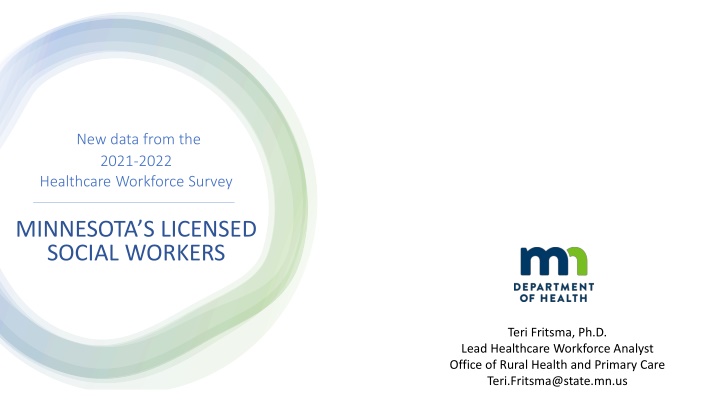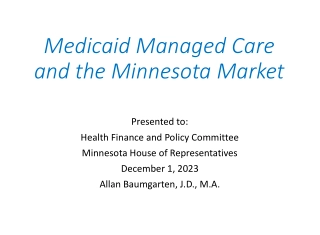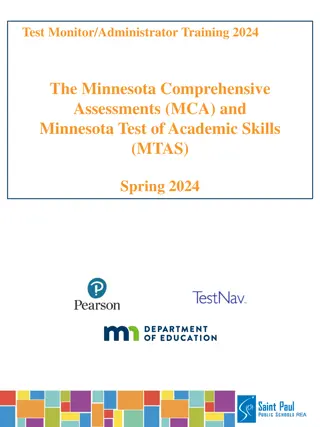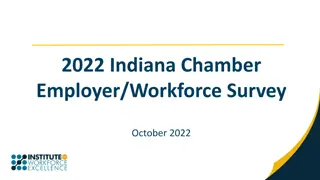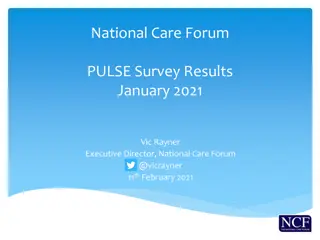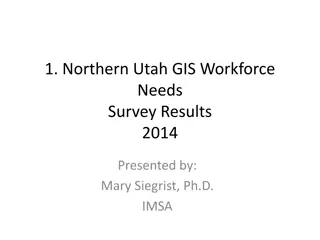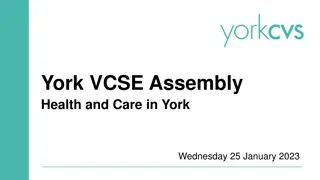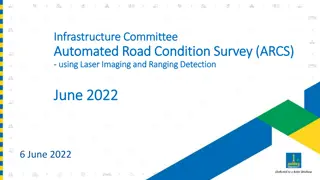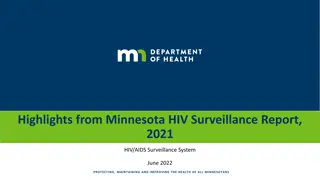Healthcare Workforce Survey 2021-2022 in Minnesota
Data from the 2021-2022 Healthcare Workforce Survey of licensed social workers in Minnesota, including demographics, education, work characteristics, and future plans. The report also covers data collection, distribution, and growth trends in the social work profession.
Download Presentation

Please find below an Image/Link to download the presentation.
The content on the website is provided AS IS for your information and personal use only. It may not be sold, licensed, or shared on other websites without obtaining consent from the author.If you encounter any issues during the download, it is possible that the publisher has removed the file from their server.
You are allowed to download the files provided on this website for personal or commercial use, subject to the condition that they are used lawfully. All files are the property of their respective owners.
The content on the website is provided AS IS for your information and personal use only. It may not be sold, licensed, or shared on other websites without obtaining consent from the author.
E N D
Presentation Transcript
New data from the 2021-2022 Healthcare Workforce Survey MINNESOTA S LICENSED SOCIAL WORKERS Teri Fritsma, Ph.D. Lead Healthcare Workforce Analyst Office of Rural Health and Primary Care Teri.Fritsma@state.mn.us
About my workgroup MDH S Health Workforce Analysis Unit Within the Health Policy Division > Office of Rural Health & Primary Care Through legislative mandate, we survey nearly all licensed healthcare providers at the time they renew their license. Our work informs: legislation, professional associations, post-secondary institutions, licensing boards, work groups, other research, and media.
Demographicsrace, age, sex Language(s) spoken in practice; cultural competence Education and preparation Work location / practice characteristics Hours worked Future plans (e.g., retirement, career mobility) What data do we collect and analyze? Providers who supervise Use of telehealth Job satisfaction / burnout New module on the factors that motivate providers on where they choose to live and practice. Unless otherwise specified, the data in this report comes from the MDH Healthcare Workforce Survey. The survey is administered at the time of license renewal. It includes most but not all licensed Minnesota social workers who renewed their license during the survey period covered here (October 15 2021 March 15 2022).
Where does our data go? (2021) MDH 20% Professional associations 13% Educational institutions 13% Media 11% State agencies (other than MDH) 11% Licensing boards 11% Other 9% Advocacy organizations 7% General public 4% Researchers We completed 76 requests in 2021. 3% State legislative request 0% Typically, about half our requests are for data/information on mental health professions.
General descriptive data on Minnesotas social workers: counts + demographics
The profession has grown in the last decade. 18,000 16,775 16,000 14,000 12,000 12,198 10,000 8,000 6,000 Number of licensed social workers by year, 2010-2021 4,000 2,000 - 2010 2011 2012 2013 2014 2015 2016 2017 2018 2019 2020 2021 Source: Minnesota Board of Social Work
Social workers, by license type, 2022 4% 19% The largest share of social work licensees are LICSWs. LICSW 42% LSW LGSW LISW 35% Source: MDH s analysis of Minnesota Board of Social Work data from March 2022.
Social workers have extremely varied work settings. Telehealth (i.e., a remote location) 22% Clinic/professional office/ambulatory care setting 22% School (K-12) 16% Hospital 10% Community or faith-based organization 9% Long-term care facility 6% Public health agency 4% Home health care 2% Primary work settings of social workers Academic (teaching/research) 2% Correctional facility 1% Other 8% Source: MDH s Healthcare Workforce Survey, October 15 2021 - March 15 2022. The chart include all four social work license types.
State where MN social workers earned their highest degree 10% Most of Minnesota s social workers completed their education in Minnesota. 4% Minnesota 11% Minnesota's border states (IA, ND, SD, WI) Other midwestern states (IL, IN, MI, OH) 75% Other states Source: MDH s Healthcare Workforce Survey, October 15, 2021 to March 15, 2022.
Age distribution of social workers vs. other mental health professions On average, social workers are younger than other mental health licensees. 35% 31% 30% 29% 30% 28% 25% 23% 23% 20% 20% 20% 19% 18% 16% 16% 15% 15% 10% 7% 6% 5% 0% < 35 yrs 35 to 44 45 to 54 55 to 64 65 yrs + Social Workers LMFTs, LPCs, and LPCCs Psychologists Source: MDH analysis of licensing board administrative records, March 2022.
Social workers as a group are just slightly more diverse than other mental health provider types. 87.1% White 89.1% 2.1% Southeast Asian 1.4% 1.0% Other Asian 1.5% 1.4% Social workers Hispanic/Latin 1.3% Other mental health providers 0.3% American Indian 0.3% 3.1% African American 1.8% 0.7% African 0.4% Race: Social workers vs. all other mental health providers 3.6% Multiple races 3.1% 0.7% Other 1.1% Source: MDH s Healthcare Workforce Survey, October 15, 2021 to March 15, 2022.
The profession is becoming more diverse. Share of non-white social workers, by age group 15.8% 13.3% 12.3% 10.6% 8.9% < 35yrs 35 - 44 yrs 45 - 54 yrs 55 - 64 yrs 65 yrs + Source: MDH s Healthcare Workforce Survey, October 15, 2021 to March 15, 2022.
Which of the followingbest prepared you to provide care to work with people a variety of backgrounds when providing care? A plurality of social workers learn cultural competence best through informal learning on the job. Informal learning on the job 39.3% Continuing education or professional development coursework 26.8% Formal on-the-job training 18.7% Formal education 14.1% None 1.0% Does not apply 0.1%
Where are Minnesotas social workers practicing (urban vs. rural)? Rural-Urban Commuting Area (RUCA) Number of social workers Share of the social work workforce Population-to- provider ratio Urban areas (dark blue) 10,014 80% 386 Large town (medium blue) 1,402 11% 433 Small town (light blue) 785 6% 497 Rural (white) 361 3% 1,210 Source: MDH s analysis of the Board of Social Work address data. Note that 8.8% of social workers had out of state addresses. Another 10% had missing address data. The counts and frequencies above are based only on social workers for whom we have valid in-state addresses.
Most social workers are using telehealth at least occasionally. How much of the care that you personally provide is via telemedicine? 39% 17% 16% 12% 10% 6% None Up to 10% 10-25% 25-50% 50-75% More than 75% Source: MDH s Healthcare Workforce Survey, October 15, 2021 to March 15, 2022.
Telemedicine helps social workers reach patients in more rural areas. Not including those who are on vacation or at a cabin, how often do you provide care via telemedicine to people who live in areas that are more rural than where you practice? At least daily or weekly 29% At least monthly 17% Occasionally, but less than monthly 24% Never 23% Don't know 8% Source: MDH s Healthcare Workforce Survey, October 15, 2021 to March 15, 2022.
Just under 20 percent of social workers plan to leave the workforce within five years. Share of social workers who say they plan to leave the workforce within 5 years Plan to leave in the next year 9% 18% Plan to leave within five years 9% 1% Urban Rural Source: MDH s Healthcare Workforce Survey, 2021-2022.
Burnout accounts for more workforce exits Share of planned workforce exits that are due to burnout or career dissatisfaction 13.9% 10.1% 5.1% 1.9% Social Workers LPCs, LPCCs, LMFTs Pre-COVID (2019) Post-COVID (2021-2022) Source: MDH s Healthcare Workforce Survey, 2021-2022
Hiring demand for social workers increased in 2021. MN job vacancy rates over time 16.0% 14.0% 14.0% 12.0% 10.0% 9.4% 8.0% 6.0% 4.5% 4.0% 1.5% 3.6% 2.0% 0.7% 0.0% 2011 2012 2013 2014 2015 2016 2017 2018 2019 2020 2021 Healthcare Social Workers Child, Family, and School Social Workers Mental Health and Substance Abuse Social Workers Source: Minnesota Department of Employment and Economic Development, 2nd quarter job vacancy survey estimates, 2011-2021.
